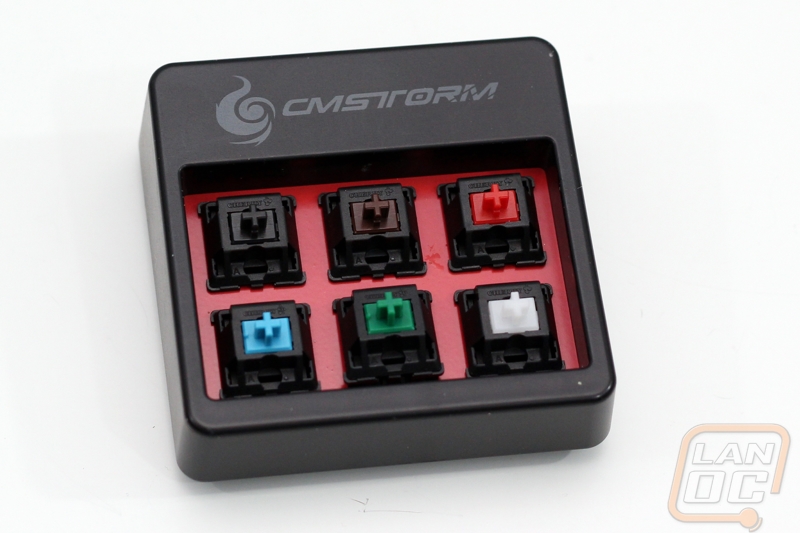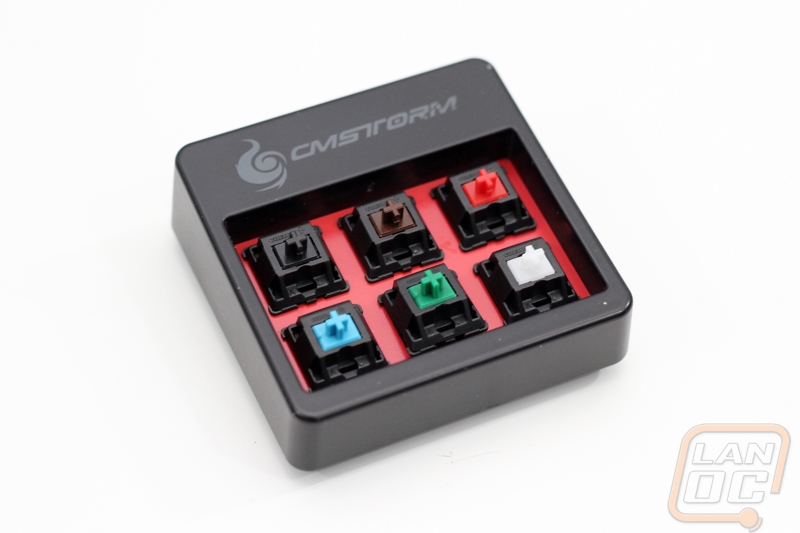If you are on the market for a new keyboard there is a good chance given the market trends that you might be considering a mechanical keyboard. Back with membrane keyboards all you really needed to consider was the keyboards features, software, and to some branding. Now, even once you have decided to go with a mechanical keyboard you have to consider what kind of switch type you want and of course most people don’t really know what the colors mean. This is one of the questions I’m asked all of the time, because of that I figured I would talk a little about it here. I hope it helps you on your decision.
Switch Sample Provided by: Cooler Master
Written by: Wes
Pictures by: Wes
For more information about keyboards, mice, or any other product that Cooler Master manufactures I would recommend visiting their new Cooler Master University website at the link below. Special thanks to Cooler Master for providing the switch sample used in our coverage.

Key Switch Brands/Types
To start things off I would like to point out that there are more mechanical keyboard switch types than you would ever want to know about. Especially when you look back to older keyboards back when mechanical keyboards were the main option. Today I want to focus on typical key switches you will come across when shopping for a keyboard.
Buckling Spring
Although this isn’t really an option with new models, we do still see a lot of people at our events that are sporting their classic IBM Model M’s. The Model M and others use a Buckling Spring switch type that is known for its loud clicks and heavy feedback. How the switch works is when you press the key down the spring is compressed and it eventually gives and buckles. When this happens the hammer at the bottom pivots and strikes the electrical contact.

Cherry
Without a doubt Cherry branded switches are the most popular switches on the market right now. To be more specific Cherry MX switches. Unless you are a big keyboard enthusiast chances are Cherry MX’s are what you will be looking for. All Cherry MX switches share the same outside shape and install the same, making these a great option for manufactures to be able to carry a variety of switch styles without making major changes in production. Cherry MX switches are also supporting adding LED backlighting to the keys, this has helped the mechanical keyboard market grow considerably in recent years. Because these are most popular they will actually be the main focus of this write up, check out the next two pages to learn more.

Topre
Unless you are a keyboard enthusiast the name Topre isn’t going to mean much. Topre key switches use a combination of a membrane style action but with a real spring inside to give them the consistent feedback that people expect from mechanical keyboards. This is a hybrid design that is fairly new on the market compared to everything else but it is also much more expensive when you do find them. For those looking for a keyboard with backlighting Topre’s aren’t a good option, they don’t offer a switch with LED lighting meaning the manufacture would have to put lighting in next to each switch, adding to the cost. I will be covering a Topre keyboard soon to talk more about their performance a little more in depth.

What do the colors mean?
If you are looking at a keyboard you might see it advertising blue key switches, or red keyswitches, ect. What is the difference between all of the colors? Well first off, all of these key switches will be Cherry MX variations. Currently there are 10 different colors/variations of the Cherry MX being produced. Of those 10 there are 6 that you might come across when shopping for a keyboard right now and I would say only 3-4 of those are well known. When looking at Cherry MX switches there are really only two things to consider, each of the switches available are just different variations of these two things.
Action
Linear- This means when you push the key down there is a smooth action all the way to the bottom of the keystroke.

Tactile- Tactile keys are similar to Linear in design but when you push them down you will feel a slight bump near the actuation point. This is to simulate the feeling you get with a Clicky switch or a buckling spring while cutting down on the noise.

Clicky- Clicky keys have a different internal design than the other two. This design incorporates two parts where the other two have one. The second part (the white part in photos) stays in place as you push down on the switch until you reach in, when that happens the second part activates the switch and the “Clicky” sound you hear is the white part of the switch hitting the bottom of its track. Clicky key switches are also considered tactile, but its best to consider them apart due to their unique Clicky design.

Spring
Different switches use different stiffness springs. They are all measured in cN aka centinewton.
Here is how they all break down. Now that you understand what it all means it’s easy to spot the similarities and differences between all of the switch types available.
|
Common Cherry MX Key Switches |
||
|
Black |
60cN |
Linear |
|
Red |
45cN |
Linear |
|
Brown |
45cN |
Tactile |
|
Clear |
55cN |
Tactile |
|
Blue |
50cN |
Clicky |
|
Green |
80cN |
Clicky |

Noise
Now that we know the differences, it’s important to understand how the differences will change your experience. A good portion of this, especially with the Tactile and Clicky switches, will be with their noise performance. For some noise isn’t an issue at all, while for others it could be a deal breaker. Cooler Master provided us with an awesome key switch tester that has all six of the switches mentioned above in it. They are tossing around the idea of manufacturing these and putting them in stores and maybe even on their store online for people to be able to try out all of the switches they offer. Some other keyboard manufactures will sell you the switches as well for you to try them out. Here is a video that shows the noise differences for each switch and if you look close you can also see the key’s action as I press down on them.
So what will work best for my situation?
Now you understand a little more about switches but you may still be wondering what you should be looking to get. Without a doubt it is mostly a preference decision, this is why if you get a chance to try a few of them out you should jump all over it. With that in mind I can give you a couple things to remember. It really comes down to Linear, Tactile, and Clicky and to help figure those out its best to know what you use your keyboard for the most.
Most people who do a lot of writing will typically prefer a Clicky type switch, assuming they can handle the noise. The feedback that a good Clicky switch gives when typing can be amazing. However, the two part design does have a drawback that can cause problems when gaming or in situations where you are trying to click as fast as possible. When you press the key in and you reach the actuation and lift up, you have to lift the key high enough for the white piece inside to deactivate the switch. Think if you pressed the gas pedal in your car down all the way but you have to take your foot off completely for it to stop. Tactile and Linear switches on the other hand have their reset point basically at the same place as the actuation point. That makes them a better choice for gaming. A happy medium between the typing and gaming switch can sometimes be the Tactile switches. You get the feedback when pressing the key to let you know that you have clicked, without the downsides to the Clicky style switches.
Once you figure out what actuation style you are looking for you should be down too two switches, the only difference being the spring stiffness. As a whole, the lighter springs (blue, red, and brown) are the most popular. Personally my preference would be browns for my PC, although I do still enjoy typing on all of the switches available.



For more information about keyboards, mice, or any other product that Cooler Master manufactures I would recommend visiting their new Cooler Master University website at the link below. Special thanks to Cooler Master for providing the switch sample used in our coverage.

